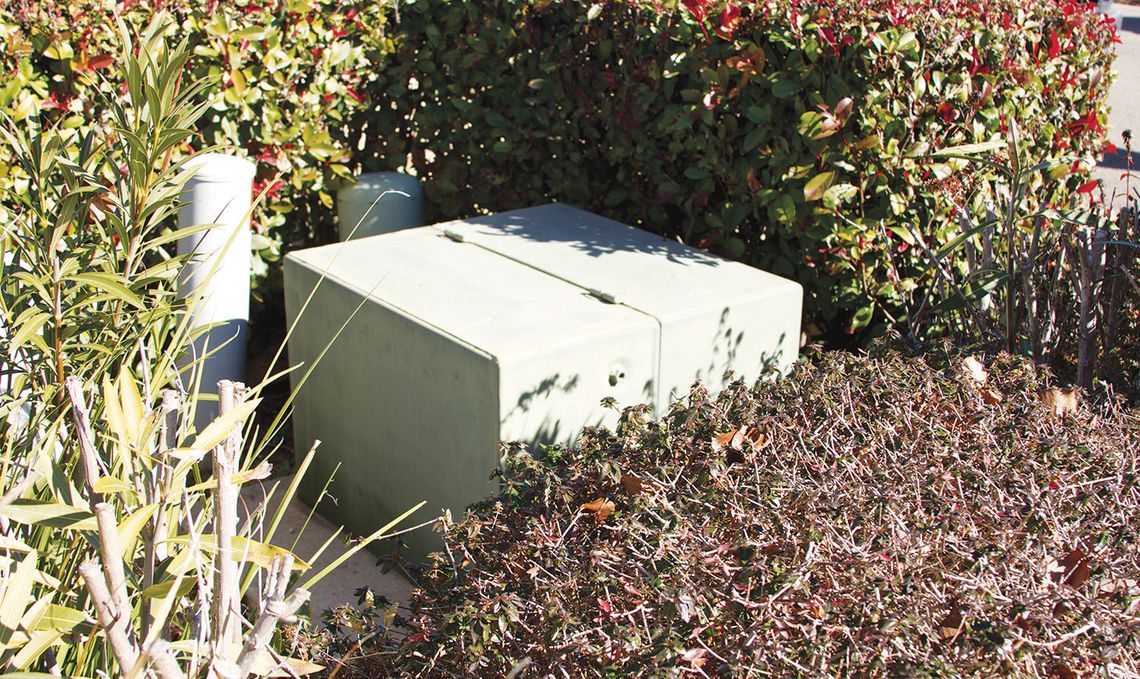JOHNSON CITY — With the spring season officially underway since March 20, the Pedernales Electric Cooperative (PEC) is warning those with a green thumb to be cautious when planting trees.
PEC’s vegetation maintenance team is made up of nine arborists and approximately 30 contract crews who service more than 8,100 square miles of service area in several counties in central Texas, including Hays County. The team’s main function is to help prevent and clear vegetation encroaching on power lines to keep members’ service safe and reliable — to help prevent power outages and potential hazards from tree limbs growing into power lines or falling onto them.
Location is key
In order to ensure that the trees will flourish, PEC reminds individuals to “look up” when they are looking at planting trees, bushes or plants of any size, so that they are not growing directly under power or electric lines. Before planting, consider the mature size of the selected species, along with falling trees and branches that may cause outages.
• Less than 25 feet in mature height: 25 feet away from power lines
• 25-40 feet mature height: 40 feet away from power lines
• More than 40 feet mature height: 60 feet away from power lines
When planting trees in a front or backyard of a house, Ryan Krause, vegetation maintenance manager, advises to have them on the west side, which is where the sun is the warmest.
“The taller trees, of course, that west sun is the hottest, so you want to make sure to plant those trees — you can plant them on either side, it’s okay, but that west sun will definitely be blocked if you plant it on that side,” he said.
Additionally, in areas with underground electric service, shrubs or other vegetation should not be planted around pad-mounted transformers. These obstructions could make maintenance work hazardous or difficult for crews, while also increasing outage restoration times.
“As far as underground equipment, it’s best not to plant within 10 [feet] of that. We have an easement that our line workers and engineers use to be able to access that equipment,” Krause said. “So, if they plant around that, it can cause longer outages and prevent us from getting into that place.”
Recommended tree types for Central Texas
The Texas Forest Service and PEC recommend the following types of trees for the climate and environment found in Central Texas, including Hays County.
15-20 feet tall
• American smoke tree
• Texas or Mexican redbud
• Desert willow
20-50 feet tall
• Lacey oak
• Mexican plum
• Bigtooth maple
60-100 feet tall
• Cedar elm
• Bald cypress
• Bur oak
It’s best to plant a variety of species native to the area to ensure disease resistance and biodiversity, Krause said.
“You really want to stay away from any kind of invasive species, not necessarily invasive, but the species that will take over or crowd out the other trees,” he explained. “A diverse species is really important in your yard. We’ve got issues with oak wilt and there's elm beetles; there's all kinds of different things that just want to take a toll on different types of vegetation out there. So, if you have a diverse species of trees in your yard … if something happens to one of them, the other one should be okay.”
When looking at planting trees around a home to save energy and ultimately, lower bills during the warmer months, Krause said that there are several options.
“Bur oaks create good shade around your home. Lacey oaks are smaller and can make great shade for south-facing windows. They have a low-spreading crown and grow slowly. Pecans tolerate heat really well and grow tall for larger homes,” he shared. “The Texas mountain laurel is a gorgeous option that blooms in spring if you’re looking to add a pop of color. They can also shade your HVAC unit to help save money and they mature at a smaller height of 10-20 feet. The Shumard oak will block about 90% of the sunlight, so that’s good to block it from your roof in the summer and your walls and windows.”
Oak wilt and protocols
Though they are used to beautify a yard or space, there are also some challenges that can be faced when planting trees, such as oak wilt. This is caused by the fungus Bretziella fagacearum, which is the most destructive disease affecting live oaks and red oaks in Central Texas, according to the Texas Oak Wilt Partnership; most of the tree mortality results from tree-to-tree spread of the pathogen through interconnected or grafted root systems once an oak wilt center becomes established. New infection centers begin when beetles carry oak wilt fungal spores from infected red oaks to fresh, open wounds on healthy oaks — wounds include any damage caused by wind, hail, vehicles, construction, wildlife or pruning.
“Oak wilt is an issue in Hays County and surrounding counties. [It’s] really important to make sure they follow the oak wilt protocols. I know a lot of people are aware of it, but that's something that PEC does as we're pruning our trees. We follow all the protocols. We communicate with our members and we'll provide assistance to our membership, but it's really important that if you don't have to prune the oak trees in the area, wait until July,” Krause explained. “There's a timeframe — end of February or March into June — that the weather is perfect and then there's a beetle that flies and will pass those fungal spores onto the other trees, potentially spreading oak wilt.”
All in all, before digging 16 inches or deeper anywhere in a yard, individuals are asked to abide by the law by calling Texas811 first; this will help notify the staff to come to the location and mark all underground equipment for free. Injury and power outages can occur when metal tools come into contact with buried electric lines. Other hazards like water and sewage, telecom and oil and gas lines could also be buried underground.
“Hays County is a beautiful area and our members care about their trees. When we’re out here doing our job, we hope that folks understand the reason for our work — and that reason is safety and reliability. We’re not here to destroy your trees or landscaping; this is all for safety reasons and to provide reliable power,” Krause said. “Keeping our lines and easements clear helps our lineworkers restore your power faster, too — because they’re able to more easily see and correct issues — with the added benefit of preventing tree damage during power restoration efforts.”
Learn more about planting trees and other vegetable maintenance at www.mypec.com.










